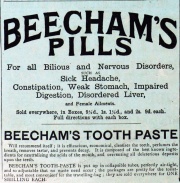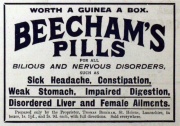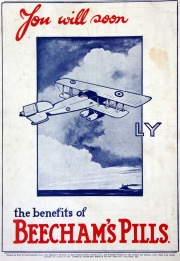Beecham Group
Beechams was the family business of Thomas Beecham (1820-1907). He was the grandfather of the conductor also named Thomas Beecham (1879–1961).
As a boy, Beecham worked as a shepherd in Oxfordshire.
From 1840 he undertook casual work at Kidlington, where for a time he acted as village postman. He also sold some pills of his own invention in nearby markets; these were made with the help of his brother in law; the main constituents were powdered aloes and powdered ginger, which acted as a mild purgative.
1842 Thomas Beecham went into business. The first product was Beecham's Pills, a laxative. Thomas became a travelling salesman, offering his pills in different parts of the country.
1847 Beecham was a labourer in Liverpool when he met and married Jane Evans from Bangor. They settled in Wigan, where he made and sold Beecham's Pills and other medicines at markets around Wigan. Business success enabled him to open a shop in the town.
1848 Thomas described himself as a "medicine vendor" at the baptism of his son, Joseph.
1850s Beecham was a "chemist, druggist and tea dealer".
After his shop failed, the family moved to St. Helens in 1859.
1859 Beechams opened its first factory in St. Helens, Lancashire, for the rapid production of medicines. The factory was the first to be opened solely for the production of medicines.
1875 Beecham was exporting his remedies to Africa and Australia.
1880s The company used fun advertisements to publicise their pills.
1885 The Thomas Beecham company acquired headquarters on the corner of Silver Street and Water Street, St Helens, England.
1887 The company's new factory in St Helens becomes the first in the area to have electricity.
1887 Another branch of the business was founded in USA
1907 Thomas Beecham died, and his sons Joseph and William took over the running of the business.
Under Sir Joseph Beecham, 1st Baronet (1848-1916) the business expanded but the company remained focussed on patent medicines and engaged little in research.
1913 Production of Beecham's Pills laxative reached one million a day.
1914 Sir Joseph Beecham was induced to underwrite the purchase for £2 million of the Covent Garden estate and market in London. The deal went awry when the outbreak of the First World War prevented the flotation of a company to sell off the properties.
After Sir Joseph's death the business was run by his executors
1924 Sold to Philip Hill
1924 Public company formed Beecham Estates and Pills Ltd which acquired Covent Garden Markets, owners of various properties in London, and the Beecham's Pills business [1]. The Beecham family was not represented on the board of directors at flotation but Sir Thomas Beecham was given the right to join the board and nominate one other director. The new company acquired the American branch of the business which had been given to Henry Beecham.
1926 Beecham's Powders were launched.
1927 Beecham Estates and Pills decided to dispose of its pills business so as to concentrate on real estate; the name of the company would be changed to Covent Garden Properties.[2]
1928 A new public company was formed: Beecham's Pills Ltd, to acquire the pills business and the great majority of the shares in the Veno Drug Co[3], maker of Veno's cough medicine and "Germolene" antiseptic.
1938 Beechams bought companies for a variety products, adding the Lucozade glucose drink, Enos Fruit Salts, and Macleans toothpaste to its product chain.
1939 It added hair products for men to its product chain by buying County Perfumery Co Ltd, manufacturers of Brylcreem
1943 It decided to focus more on improving its research and built Beecham Research Laboratories.
1944 The company was named Beecham Group Ltd.
1945 Beecham Research Laboratories Ltd operated from Brockham Park, Surrey.
1949 or 1953 Company bought C. L. Bencard, which specialized in allergy vaccines, the company's first acquisition in the field of prescription medicine.
1954 Silvikrin Laboratories Ltd, A. Rowland and Sons Ltd, Automatic Hair-Cream Vending Machines Ltd were all put into voluntary liquidation with the same liquidator[4]
1955 Acquired H. W. Carter and Co, manufacturers of Ribena blackcurrant drink.[5]. Formation of Beecham Foods.
By the mid 1950s the group comprised some 100 smaller companies, including a large wholesale grocery business which was sold off later.
1957 Company researchers isolated the penicillin nucleus 6-aminopenicillanic acid (6-APA). This discovery allowed the synthesis of a number of new semi=synthetic penicillins.
1958 Acquired Pure Lemon Juice Co. A new toiletries factory was opened at Maidenhead, reflecting the increased business in shampoos, deodorants and hair sprays.
1958 Acquired Thomas and Evans, makers of Corona Soft Drinks.[6]
1959 Beecham signed an agreement with Bristol-Myers to market the medicines in the USA and gained advice on the new factory at Worthing
In the 1950s to 1960s the 2 groups together developed penicillin derivatives including pheneticillin, then the more potent methicillin (Celbenin). Later these were followed by Ampiclox and others as the group focussed on pharmaceutical development
1959 Beecham marketed Broxil (phenethicillin), followed shortly by Celbenin (methicillin) that is active against Staphylococcus aureus.
1961 Penbritin (ampicillin) hit the market, and soon Beecham's facilities were inadequate for the worldwide demand.
A 35-acre complex at Worthing came on line in the early 1960s to produce 6-APA, the base for semisynthetic penicillins.
1961 Employs 14,450 persons. [7]
1967 Acquired Vitamins Ltd, which reinforced the developing interest in veterinary medicine.
1969 Acquired Horlicks Malted Milk Co
1969 The company's business was:
- Pharmaceutical and veterinary - 30 percent
- Consumer Products - 65 percent
- Animal feedstuff concentrates and health products - 5 percent
1971 Beecham attempted to take-over Glaxo, which had a much larger pharmaceuticals business, but was unsuccessful after a Monopolies Commission investigation.
1972 Beecham launched Amoxil, which went on to become one of the most widely prescribed antibiotics.
1980 General Occidentale sold Bovril, Marmite and Ambrosia to Beecham Group[8]
1981 Beecham introduced Augmentin, an antibiotic used to treat an array of bacterial infections.
1986 Sold various food business to Hillsdown Holdings
1989 The Beecham Group plc and SmithKline Beckman merged to form SmithKline Beecham plc.
1989 Production of "Beecham's Pills" ceased.
2001 SmithKline Beecham and Glaxo Wellcome merged to form GlaxoSmithKline.

































